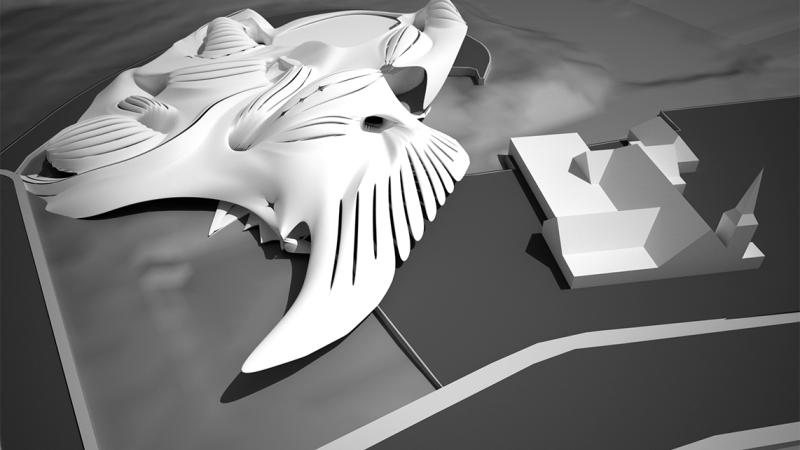Students Developed Concepts To Create Greater Presence in Downtown Site
October 22, 2013

miSci, the Museum of Innovation and Science in Schenectady, will host an exhibit in October and November featuring Rensselaer School of Architecture students’ design proposals for a re-envisioning of the museum campus.
The exhibit, which opened Oct. 23, showcases the results of a design studio that second-year students attended last fall semester. School of Architecture Dean Evan Douglis said the miSci project is the third in a series, called the Capital Region Collaborative Initiative, which he launched upon his arrival at Rensselaer.
“We’ve worked with the Shaker Museum, the Hyde Collection, and now miSci,” Douglis said. “This exhibit is the culmination of a full semester of study by the entire second-year student body. They were charged with examining the existing museum campus, learning the history and mission of the museum, and developing design options that will transform the museum into a contemporary cultural magnet.”
Neil Golub, Price Chopper’s executive chairman of the board, has long championed miSci and has been heavily involved in recent programs to transform the museum, formerly known as the Schenectady Museum, into a regional hub of science and innovation. Golub’s wife, Jane Golub, is a member of the museum’s Board of Trustees.
“This is a foundation for ideas and inspiration,” said Golub. “Getting students from Rensselaer involved helps us to expand our reach throughout the Capital Region and continues to position miSci as a regional science center, focusing on educating and intriguing the youth of our region in STEM (science, technology, engineering, and math). These designs represent both something to aspire to as well as proof that STEM education works for the students in this program and for our community.”
MiSci Executive Director William “Mac” Sudduth played an integral role in the students’ design process, giving his time to explain the museum’s mission, role in the community, and describing his vision for the future.
“As an informal educational institution, miSci always loves working students and the RPI students were just delightful to work with,” Sudduth said. “What was really wonderful was that they learned something, but we learned some things, too.”
During the design studio, students were asked to consider limitations in the present facility including its lack of visibility—the museum sits on a hill overlooking downtown Schenectady and cannot be seen from the main road—as well as its distance from passing traffic and underutilized landscape, said Douglis.
A book of the students’ designs also was produced and will be distributed to a selection of students, faculty, Rensselaer leaders, and distinguished alumni and alumnae. The exhibit showcasing those designs will be open through Nov. 23 and is open to the public with regular admission prices. More information about miSci is available at www.miSci.org.
“The second-year design studio is a pivotal moment in the education of an architect. This is their first experience designing a building, so it’s quite a monumental passage for our students. Speaking on behalf of the entire student body and faculty associated with this collaborative initiative, the opportunity to work with the leadership at miSci as well as Neil Golub was inspiring and offered an invaluable educational opportunity for everyone,” said Gustavo Crembil, Rensselaer’s School of Architecture project coordinator.
About miSci
miSci is located at 15 Nott Terrace Heights in Schenectady. miSci is open 9am to 5pm Monday through Saturday and 12 to 5pm Sunday. Admission to miSci is $6.50 for children 3 - 12; $8 for seniors 65 and older; $9.50 for adults; add $5 for a Planetarium Show. For more information, please call (518) 382-7890 or visit www.miSci.org.
Founded in 1934, miSci is the only science center in Tech Valley offering a multimedia experience for visitors of all ages and serves school children from northeastern New York, western Massachusetts, and southern Vermont. In 2012, miSci entered into a partnership program with the San Francisco-based Exploratorium’s ExNET (Exploratorium Network for Exhibit-Based Teaching) program, miSci receives a different group of hands-on, exploratory-rich exhibits each year for five years, as well as access to the Exploratorium resources to advance each partner’s work in specific areas such as education, inquiry, science engagement, and exhibit development. The Suits-Bueche Planetarium at miSci houses the only GOTO Star Projector in the northeast and is an official NASA Space Place. miSci’s Archives include an extensive GE Photograph collection, with more than 1.6 million prints and negatives; an archival collection with more than 3,500 cubic feet of historic materials; and more than 15,000 objects relating to the history of science and technology. miSci’s Archives houses an 1878 Edison tinfoil, the second oldest documented Edison tinfoil recording, the oldest playable American voice. miSci offers Science Zone, with weekly hands-on activities and challenges; Saturday Science Zone activities are sponsored by National Grid.
About Rensselaer Polytechnic Institute
Founded in 1824, Rensselaer is the nation’s oldest technological research university. The university, which has undergone an extraordinary transformation during the last decade, offers bachelor’s, master’s, and doctoral degrees in engineering, the sciences, information technology and web science, architecture, management, and the humanities, arts, and social sciences. Institute programs serve undergraduates, graduate students, and working professionals around the world. Rensselaer faculty are known for pre-eminence in research conducted in a wide range of fields, with particular emphasis in interdisciplinary research in the areas of biotechnology and the life sciences, energy, the environment, and smart systems, nanotechnology and advanced materials, computational science and engineering, and media and the arts. The Institute is noted for its success transferring technology from the lab to the marketplace so that new discoveries and inventions benefit human life, protect the environment, and strengthen economic development.